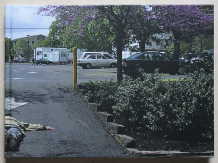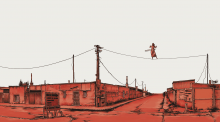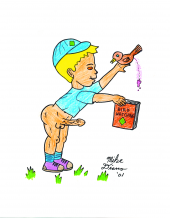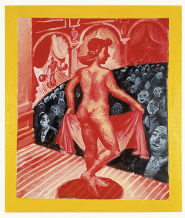| Zeitschrift Umělec 2001/1 >> Lemme Do It! | Übersicht aller Ausgaben | ||||||||||||
|
|||||||||||||
Lemme Do It!Zeitschrift Umělec 2001/101.01.2001 Tomáš Tahoda | exhibition | en cs |
|||||||||||||
|
"Out of the jumble of recent theme exhibitions, it’s the shows curated by those lacking an established art historical background that have stood out.
To make their exposition menus more varied and lively, institutions have invited artists, and sometimes writers, philosophers and representatives of other professions, to offer a new look, consciously liberated from traditional forms of presentation and other “limiting” and prescriptively “mandatory” criteria. And since such curators are not professionals in the field, they can more legitimately emphasize a subjective interpretation. Anna and Icarus The end of last year saw two big exhibitions conceived by two well-known international artists. British film director Peter Greenaway turned Malmö Kunsthalle into a flea market that played with the theme of Icarus’ fall. From the myth of the optimistic and promising flight and the hopeless and tragic fall, Greenaway created a labyrinth of accumulated metaphorical and allegorical forms. Airplane propellers and birds’ wings mingled with countless variations on the theme of water as a changeable element. The silence of huge, slowly melting icebergs was broken by the dense rain pouring onto a tiled autopsy room that had been dug into the ground (Icarus’ final destination). Meanwhile, the Museum of Decorative Arts in Copenhagen invited the American artist Robert Wilson to mount an exhibition using the entire building and its collection as a starting point for a new installation of the collection. Director Turned Curator Director, set designer and designer Robert Wilson combines dance, poetry, drama, music, architecture and design in his creations. He is mostly known for his theater projects, but he is also active in video, film and art exhibitions. Working with his creative team in the multidisciplinary laboratory Watermill Center on Long Island, New York, Wilson’s multimedia projects often take on the character of total Gesamtkunst-werk. He gained fame for a number of extreme, minimalistically stylized, super-esthetic performances carried out in cooperation with well-known stars of contemporary music. These included Einstein on the Beach (1984) with Philip Glass, The Man in the Raincoat (1987) with Laurie Anderson, The Forest (1988) with David Byrne and Heiner Müller, The Black Rider (1990) with Tom Waits and William Borroughs, Time Rocker (1996) with Lou Reed and Darryl Pinchney, Monsters of Grace (1998) with Philip Glass, and POE-try (2000) with Lou Reed. In addition to the opera Woyzeck by Georg Büchner, which he staged in cooperation with Tom Waits, Wilson organized a large exhibition entitled Anna Didn’t Come Home That Night at the Copenhagen museum. He was free to choose the exhibits and the style of their presentation and in the end he completely transformed the museum. It became a a magic box of shifting moods, a teatrum mundi that turned a stroll through the museum space into a pilgrimage through a mysterious world peopled by unexpected gatherings of objects. This project, however, was not Wilson’s first encounter with a museum collection. Among preceding projects of this type were his exhibitions Energy (1990) at the Stedelijk Museum in Amsterdam, Portrait, Still Life, Landscape (1993) in Boymans van Beuningen Museum in Rotterdam, and the highly acclaimed Armani, which opened at the Guggenheim in New York in 2000. The Phenomenon of the Museum Art meets theater in Wilson’s tableaux. As with the actors who move like remote-controlled marionettes in his performances, objects in his works levitate as if in a state of weightlessness. They float in space, where we observe them in fascination as if they were mummified, motionless in time. Things become performers in a staged play where each object gives off an aura of uniqueness and exclusiveness, aspiring to be a work of art. Reading and interpretation are left open for the viewer, who co-creates the content. Wilson refers to Zen thought with its multiplicity of interpretations. By accumulating objects with different functions, from various periods and provenance, objects that lack system or category, Wilson questions the way historic materials are usually treated in different contexts. Museums are monuments to the human will to create and influence the world with their dreams, work and desires. They are endlessly filled with new things for exhibition and interpretation. They all tell different stories, and it is up to the museum to decide which stories are told, and how they are told to the viewers, and this process is influenced by specific traditions. The Museum of Modern Art in Esbjerg attempted to analyze the institution of the museum from the perspective of the communication it is associated with. The museum’s objective was to work out the semiotics of a museum developed in the spirit the receptively oriented theory of Umberto Eco. The museum has installed and presented its permanent expositions according to esthetic principles rather than traditional stylistic and art historical categorizations. Likewise, Wilson cultivates the museum as a magical place of seeing and of sensual experiences. He removes objects from their normal contexts, and set against monochrome backgrounds and under effective, often subtle, lighting they become objects per se. Wilson, the Surrealist Surrealism searched for hidden meaning in objects taken out of their everyday contexts. A flea market thus became a museum where an endless number of things were waiting to be discovered and presented as objets trouvés, artifacts. Wilson’s feeling for irrational objects, the mysticism of things and their arrangement into improbable constellations draws on the tradition of Baroque Wunder-kammer, collections of curiosities, scientific machines, art, and exotic flora and fauna. Collages by Max Ernst, André Breton’s collections of fetishes and anthropological objects, and the miniature world of magic boxes by Joseph Cornell also parallel his approach. Names like Marcel Duchamp and Kurt Schwitters come to mind too, because they worked with objects removed from their contexts and played with the meanings of ordinary things. The Road In his theater pieces, Wilson mobilizes all the senses. His installations are complemented by sounds, music, smells, dramatic light effects, sophisticated work with colors, texture and space as well as live actresses. “For me the structure of an exhibition is like a road; one space complements another. I construct space and time, different rhythms just like in music and architecture. I try to unite order and chaos, to create the coexistence of opposites, to create sense through a contrast of differences,” says Wilson. The exhibition Anna Didn’t Come Home That Night was conceived as a number of stop-offs on a final journey for the fictitious character Anna. Each room’s inventory, their individual atmospheres and natures, represented uncertain evidence of Anna’s missing physical presence. Like somebody reading Alice in Wonder-land, the viewer fell into a slight trance of temptation and astonishment. It was a Baudelaire-like “forest of correspondence and relationships” where scale, space and time continuously shifted. Sixteen stops were made in sixteen rooms containing fantastic compositions of artifacts from various periods and cultures, forming the kind of strange, irrational, indescribable world we know from the paintings of Magritt and Giorgio de Chirico. Paradise A Baroque cabinet with embroidered miniature pictures on every drawer. A picture of paradise, Adam, Eve and two unicorns in the middle. Two mammoth Baroque wardrobes. Artfully carved, set into space like buildings in a landscape. The dim light picked out the gloss on the carving and the wood’s structure. An old ski complete with a ski boot leaned against the back of one wardrobe. A small mysterious package in brown paper, bound with string, was hanging high up in the opposite corner of the room. On the walls, dimly lit wooden Gothic relief. A futuristic three-legged chair designed by Philip Starck was placed under a spotlight. The paradise scene was repeated as a spatial theater scene in a closed box with an opening. A glass gun. Relief. Mystery. Time going backwards. Tables and Chairs Tapestries with the motif of a traveling emperor. A Baroque chair and tables wrapped in white cloth. Only the corner of a commode or the leg of a chair peeped out. White porcelain sculptures of birds on high plinths. Maria Calas and Tom Waits singing. A fallen tree branch jutting through a window into the room. White porcelain figures in half-empty cabinets. Departure. Exit. Abandonment. Workshop Scratched ladders. Scattered buckets with paint, brushes, and rollers. Radios. Each was tuned to a different station. Technical drawings of chairs, interiors, lamps. Erotic Japanese woodcuts piled on top of each other on a desk. Confusion. Cacophony. Mess. Process. Dining Room A long table. Thirty-four guests to be served. Thirty-four different chairs. White china. Cut glass, silver. Artichokes were piled up between the plates. On each plate was a yellow and a pink pill. Big bulbs over the table and a crystal chandelier in the middle. The heavy smell of mahogany. Subdued conversation, the tinkling of silverware and glass. Mirror Hall A mirror foil covered the walls. Four different Baroque mirrors on each wall multiply the reflection into infinity. Crystal chandeliers. The play of light and reflections. The museum’s delicate treasures were placed on sloping surfaces within perspective embrasures. Porcelain chickens and cabbage. Glasses with threatening skittle-like balls above them. A tiny figure made of ivory. A silver tray. A clock. Infinity. Mirroring. Translated by Vladan Šír. "
01.01.2001
Empfohlene Artikel
|
|||||||||||||
|
04.02.2020 10:17
Letošní 50. ročník Art Basel přilákal celkem 93 000 návštěvníků a sběratelů z 80 zemí světa. 290 prémiových galerií představilo umělecká díla od počátku 20. století až po současnost. Hlavní sektor přehlídky, tradičně v prvním patře výstavního prostoru, představil 232 předních galerií z celého světa nabízející umění nejvyšší kvality. Veletrh ukázal vzestupný trend prodeje prostřednictvím galerií jak soukromým sbírkám, tak i institucím. Kromě hlavního veletrhu stály za návštěvu i ty přidružené: Volta, Liste a Photo Basel, k tomu doprovodné programy a výstavy v místních institucích, které kvalitou daleko přesahují hranice města tj. Kunsthalle Basel, Kunstmuseum, Tinguely muzeum nebo Fondation Beyeler.
|





































 Potsdamer Str. 161 | Neu Divus in Zwitschermaschine, galerie und buchhandlug in Berlin! | Mit U2 nach Bülowstraße
Potsdamer Str. 161 | Neu Divus in Zwitschermaschine, galerie und buchhandlug in Berlin! | Mit U2 nach Bülowstraße
Kommentar
Der Artikel ist bisher nicht kommentiert wordenNeuen Kommentar einfügen